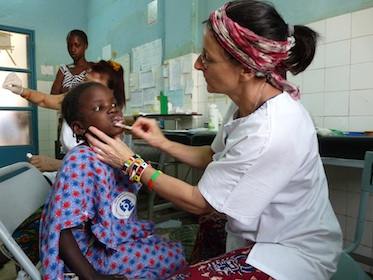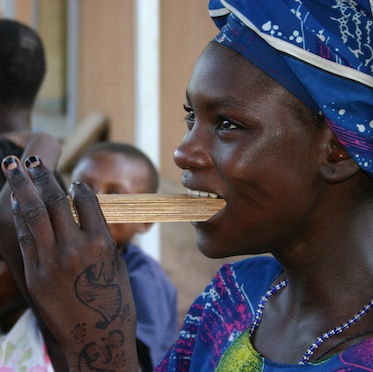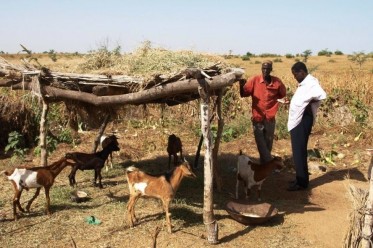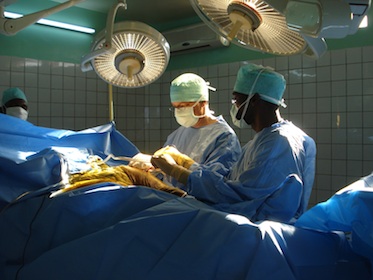- c/o Winds of Hope Foundation, Ch. de Montolivet 19, 1006 Lausanne, Suisse
- +41 (0)21 320 77 22
- info@nonoma.org
« We can’t change the whole world, but we can radically change the life of one person, and then another and then the next and yet another. » Dr Gary Parker
Pre- and post-operative care

- Organizing pre- and post-operative care: This includes all aspects of caring for a patient who is going to undergo surgery, starting with reception; preoperative examinations (x-rays, blood tests); assessment of general state of health; implementation of any treatment needed (correction of nutritional deficiencies, de-worming, initiation of a good diet, hygiene); physical and psychological preparation for the operation; escorting patients to the operating theatre, and monitoring them as they come round in the recovery room; management of treatments / prescribed care (wound care, dressing, follow-up, etc.); treatment in the care home; maintaining care plan and health record. Besides nursing, entertainment and educational activities are often organized in parallel, the object of which is to allow patients to overcome their pain and anxiety (games and play activities, tutoring, hygiene and nutrition). Prior to accompanying a surgical mission, there is the whole logistical organization (recruitment of personnel, planning, meetings, organization of travel, accommodation of staff on the spot etc.) which will allow nurses, facilitators, and organizers – volunteers for the most part – to offer their time and skills to the patients who have undergone operations.
- Training local staff to care for children on the spot: transferring skills, and coordinating work between healthcare teams so that the local nurses can take over when those who have come to the country with the surgical mission return home.
Surgical missions
- Organizing surgical campaign missions to reconstruct very badly disfigured faces. Those suffering from less serious sequelae are given surgical treatment by local staff. Surgeons specializing in facial reconstruction travel out to Africa and collaborate with local surgeons to operate on the children. These missions are often characterized by rudimentary local conditions. The missions are intended for the treatment of cases with relatively little loss of tissue.
- Severely disfigured children who require complex treatment that cannot be provided locally have to be referred, and their transportation overseas organized. Transfer abroad is justified when microsurgery, intensive care or multi-stage reconstruction is required. The conditions required then are reduced costs, short hospitalizations and a home for post-operative care. For example, from 1984 to 2013, 206 children with noma sequelae and 42 children with craniofacial malformations, congenital or acquired, were transferred and treated at the University Hospital of Geneva.
- Establishing a specialized surgical treatment unit for the West African region. Significant emphasis is placed on teaching and knowledge transfer during surgical missions. Training courses are offered to local doctors. Medico-surgical centres are built in order to be able in the long term to restrict the number of children transferred, as this requires a complex organization.
Individual Rehabilitation

Rehabilitation encompasses all the methods used to restore the usage of a limb, organ or function in a person: massages, thermotherapy, active or passive mobility, sensory and tactile stimulation, stretching, etc. It must take into account all the parameters of the case-history (each patient having his own specific characteristics: type of sequelae, scar healing, personal experience, age, etc.) in order to restore lost functions and damaged organs. In the case of noma, the absence of rehabilitation increases the risk of recurrence of permanent constriction of the jaw. Under this heading, activities such as the following are included :
- Rehabilitation of patients operated on for noma sequelae by means of appropriate treatment and physiotherapy
- Organization and implementation of patient rehabilitation
- Involvement of patients and families in post-operative care
- Training of local healthcare teams in rehabilitation techniques so as to ensure long-term therapeutic follow-up
- Wider dissemination of rehabilitative techniques
Reintegration into society and workplace
From the moment a child patient is discovered to the day when he has his face restored, and long after his return to his family, he has to be monitored to prevent him from falling back into pain and being forgotten. Individualized help for the child and his family, both medical and social care, is vitally important. This involves multiple activities :
- Helping patients reintegrate into their families and communities
- Organizing the follow-up of children in their families by social workers
- Carrying out administrative procedures for putting children into school or obtaining social assistance
- Giving professional training to cured former noma children
- Providing assistance to victims and their families to avoid a relapse into poverty: medical aid, food, school and social assistance (housing, livestock or small business assistance (micro-credits))
- Following up the individual aid decided upon according to the personal and family situation of each child, taking into account local conditions.



